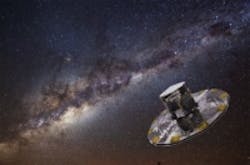Largest camera in the world to create 3D map of Milky Way
When the Gaia Space Telescope launches this October, it will be equipped with the largest digital camera in the world, which will capture images of more than one billion stars to create the most detailed 3D map of the Milky Way galaxy ever created.
Gaia will have two mirror telescopes that will act as “eyes” and provide stereoscopic vision, which enables it to see in 3D. The e2vimage sensors—which will have more than a billion pixels—will record images captured by the telescopes. The camera’s sensor measures one and a quarter square feet and is made up from 106 light sensitive electronic chips, according to The Telegraph.
Equipped with this technology, Gaia will be able to see more than 150,000 light years, or 900,000 trillion miles into space. The image sensor is so powerful that it would be able to distinguish a single hair more than 430 miles away. Professor Gerald Gilmore, UK principal investigator on the Gaia mission based at the University of Cambridge told The Telegraph that the Gaia Space Telescope will provide new, previously unattainable information, such as determining the location of stars on a flat plain.
“It is something we will never be able to do on earth because the atmosphere blurs everything and introduces colors,” he said. “Gaia is going to open our eyes to layers of information that we can only dream of.”
The images captured on the Gaia Telescope will be studied by astronomers who hope to pinpoint the exact position of the Milky Way galaxy while also trying to determine how the galaxy is growing. Pictures beamed back to Earth to create the 3D model of the galaxy are estimated to contain enough data to fill 1.5 million CDs.
View the Telegraph article.
View an e2v press release.
Also check out:
e2v to supply imaging sensors for GAIA space mission
Multispectral imaging captures views of Mars
Vision-enabled subs will search for alien life
Share your vision-related news by contacting James Carroll, Senior Web Editor, Vision Systems Design
To receive news like this in your inbox, click here.
About the Author

James Carroll
Former VSD Editor James Carroll joined the team 2013. Carroll covered machine vision and imaging from numerous angles, including application stories, industry news, market updates, and new products. In addition to writing and editing articles, Carroll managed the Innovators Awards program and webcasts.
